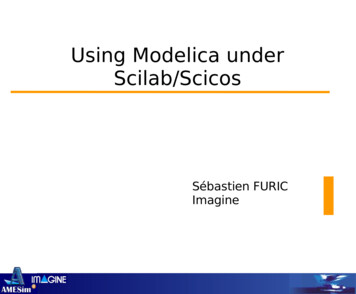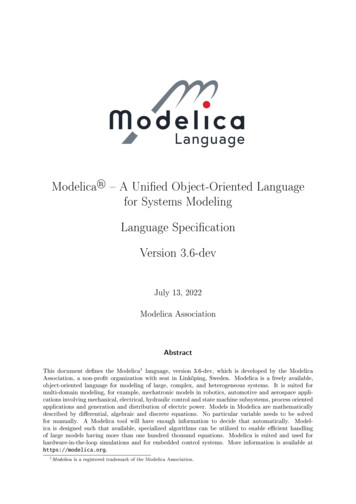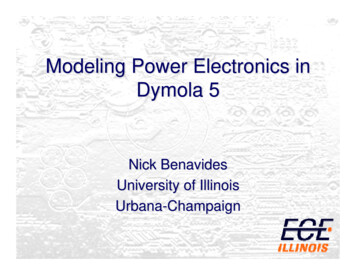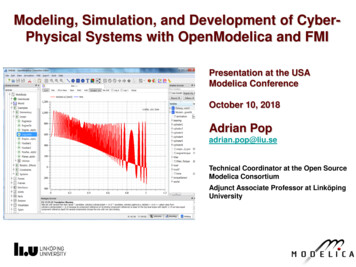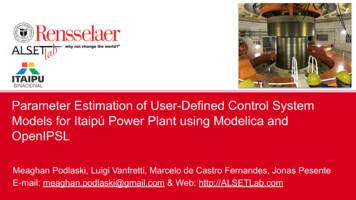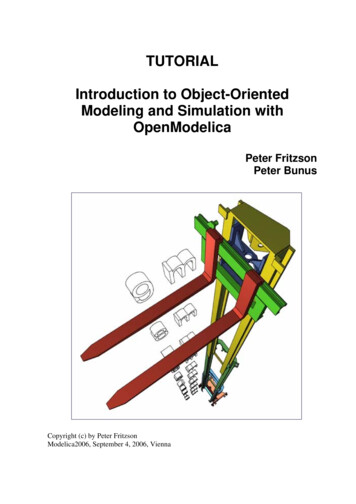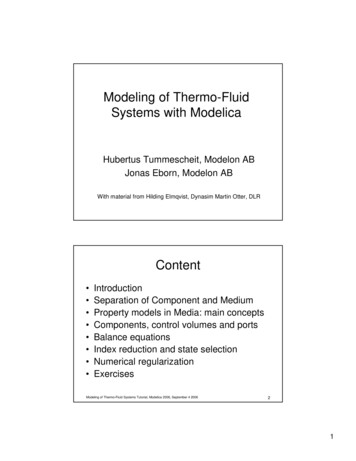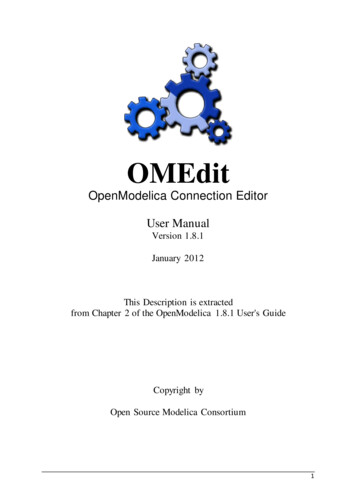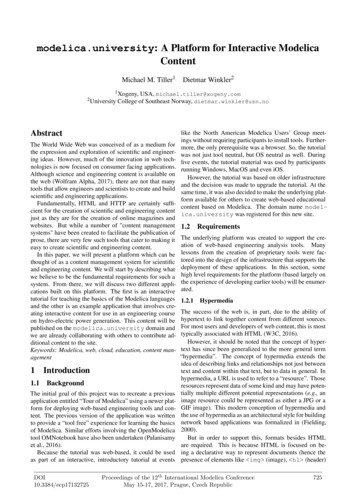
Transcription
modelica.university: A Platform for Interactive ModelicaContentMichael M. Tiller1Dietmar Winkler21 Xogeny,2 UniversityUSA, michael.tiller@xogeny.comCollege of Southeast Norway, dietmar.winkler@usn.noAbstractThe World Wide Web was conceived of as a medium forthe expression and exploration of scientific and engineering ideas. However, much of the innovation in web technologies is now focused on consumer facing applications.Although science and engineering content is available onthe web (Wolfram Alpha, 2017), there are not that manytools that allow engineers and scientists to create and buildscientific and engineering applications.Fundamentally, HTML and HTTP are certainly sufficient for the creation of scientific and engineering contentjust as they are for the creation of online magazines andwebsites. But while a number of "content managementsystems" have been created to facilitate the publication ofprose, there are very few such tools that cater to making iteasy to create scientific and engineering content.In this paper, we will present a platform which can bethought of as a content management system for scientificand engineering content. We will start by describing whatwe believe to be the fundamental requirements for such asystem. From there, we will discuss two different applications built on this platform. The first is an interactivetutorial for teaching the basics of the Modelica languagesand the other is an example application that involves creating interactive content for use in an engineering courseon hydro-electric power generation. This content will bepublished on the modelica.university domain andwe are already collaborating with others to contribute additional content to the site.Keywords: Modelica, web, cloud, education, content management11.1IntroductionBackgroundThe initial goal of this project was to recreate a previousapplication entitled “Tour of Modelica” using a newer platform for deploying web-based engineering tools and content. The previous version of the application was writtento provide a “tool free” experience for learning the basicsof Modelica. Similar efforts involving the OpenModelicatool OMNotebook have also been undertaken (Palanisamyet al., 2016).Because the tutorial was web-based, it could be usedas part of an interactive, introductory tutorial at eventsDOI10.3384/ecp17132725like the North American Modelica Users’ Group meetings without requiring participants to install tools. Furthermore, the only prerequisite was a browser. So, the tutorialwas not just tool neutral, but OS neutral as well. Duringlive events, the tutorial material was used by participantsrunning Windows, MacOS and even iOS.However, the tutorial was based on older infrastructureand the decision was made to upgrade the tutorial. At thesame time, it was also decided to make the underlying platform available for others to create web-based educationalcontent based on Modelica. The domain name modelica.university was registered for this new site.1.2RequirementsThe underlying platform was created to support the creation of web-based engineering analysis tools. Manylessons from the creation of proprietary tools were factored into the design of the infrastructure that supports thedeployment of these applications. In this section, somehigh level requirements for the platform (based largely onthe experience of developing earlier tools) will be enumerated.1.2.1 HypermediaThe success of the web is, in part, due to the ability ofhypertext to link together content from different sources.For most users and developers of web content, this is mosttypically associated with HTML (W3C, 2016).However, it should be noted that the concept of hypertext has since been generalized to the more general term“hypermedia”. The concept of hypermedia extends theidea of describing links and relationships not just betweentext and content within that text, but to data in general. Inhypermedia, a URL is used to refer to a “resource”. Thoseresources represent data of some kind and may have potentially multiple different potential representations (e.g., animage resource could be represented as either a JPG or aGIF image). This modern conception of hypermedia andthe use of hypermedia as an architectural style for buildingnetwork based applications was formalized in (Fielding,2000).But in order to support this, formats besides HTMLare required. This is because HTML is focused on being a declarative way to represent documents (hence thepresence of elements like img (image), h1 (header)Proceedings of the 12th International Modelica ConferenceMay 15-17, 2017, Prague, Czech Republic725
modelica.university: A Platform for Interactive Modelica Contentand p (paragraph). But in order to generalize theapproach to data, a whole range of new formats likeHAL (Kelly, 2016), Collection JSON (Amundsen, 2013)and Siren (Swiber, 2016) were developed.The most essential aspect of these formats is that theyallow generalized data (in most cases serialized as eitherXML (Maler et al., 2008) or, more commonly, JSON(ECMA International, 2011)) to express hypermedia concepts like relationships to other resources and/or actionsthat can be performed on these hypermedia resources.At the dawn of the World Wide Web, hypermedia wasrecognized as an essential component for the expressionand exploration of scientific and engineering ideas. Ourexperience shows that the power of applying hypermediaconcepts to science and engineering is still not fully realized and our goal was to not only include it as a requirement for managing scientific and engineering content, butto exploit it even further than most existing platforms.yond simple static markup requires a wider range of skills.Unfortunately, people with those skills tend to be drawnto more “consumer oriented” projects with the potentialto reach very large markets (social networking, advertising, search engines, games, etc.). As a result, the rate ofinnovation and adoption in the engineering sector has traditionally been and continues to be slow.In order to break this cycle, it is essential to developtechnologies that make it easy to turn people with specialized scientific or engineering skills into content creators.Of course, this is nothing new. But, again, many of the development resources are focused on empowering broadersections of society and less on science and engineering.In reducing the learning curve for non-experts, there aretwo important aspects to consider. The first is easing thecreation of content. This means being able to easily makescientific and engineering content accessible through theAPIs, e.g., connecting the API to existing data sources orcomputational capabilities. The other aspect is the visual1.2.2 APIization of the underlying content in the web browser. ForNearly all web applications require some kind of API to in- the purposes of this project, we require that both of theseteract with. Generally speaking, the two main functions of are facilitated to some extent.an API are to provide information and the carry out tasks.1.2.4 Third Party ToolsThe term “Command Query Responsibility Segregation”(CQRS) refers to an architectural style where these two re- While modelica.university is being hosted pubsponsibilities are clearly and cleanly delineated (Fowler, licly, the infrastructure it is build on was developed to sup2011).port proprietary tools and applications. Many of those apAs such, it is no surprise that our API requires both plications are intended to be hosted on private networks. Itof these functions. An API is generally just the “mid- is quite common that customers insist that all data remaindle man” between the client (e.g., the web application) on private networks. In those cases, it is impossible to relyand one or more sources of information leveraged by the on third party services hosted on the public Internet (e.g.,server (e.g., databases, file systems). The query function- Amazon EC2, Google Cloud Platform, Digital Ocean).ality allows the web application to request informationSo none of the software libraries used by the modelfrom those sources via the API. The command function- ica.university infrastructure rely on services thatality allows the web application to request tasks to be per- are hosted exclusively on the public Internet. Howeverformed by the server. The main difference between the the requirement to avoid public services was relaxed forcommand and query functionality is that queries are, gen- this project to make deployment easier and more cost eferally speaking, idempotent, i.e., they don not change the fective.state of the server while the command functionality typically exists solely for the purpose of mutating the server 1.2.5 Job Processingside state. Furthermore, querying functionality generally In our earlier discussion on APIs, we mentioned the needrelies on caching as an optimization to speed up the fetch- to perform “computational tasks”. But for scalability reaing of information and to ensure its “freshness” while com- sons, it is frequently important to delegate these compumands frequently invalidate caches as a result of mutation. tational tasks away from the API server. Without suchFor our purposes, we need querying functionality to delegation, the response of the API server itself could beprovide us with text, images, models, simulation results, slowed down considerably by CPU intensive tasks runningetc. We need the command functionality mainly to re- on the same machine. Furthermore, numerical tools arequest computational tasks like simulations and optimiza- often written in languages like FORTRAN, C , Python,tions to be performed.Julia, etc., while web servers, databases and other backend services are written in languages like Javascript, Java1.2.3 Content Creationand so on. To address both the scalability and interoperA significant impediment to web and cloud adoption in ability, it is often convenient to introduce message queuesthe world of science and engineering is the fact that there or worker queues. These provide a way to link togetheris not much overlap in technical skills between engineers various services in a scalable way while avoiding the tenand web developers. As such, engineers need to rely on dency toward monolithic architectures. The term “miweb developers to help them with creation of web based croservices” (Susan Fowler, 2016) refers to an architectools. Of course, HTML is relatively easy. But to move be- tural style which is very much aligned to these require726Proceedings of the 12th International Modelica ConferenceMay 15-17, 2017, Prague, Czech RepublicDOI10.3384/ecp17132725
Session 10B: Modelica Language & Toolsments.2Content Management PlatformNow that we have elaborated some of the requirementsfor the application, we will quickly review how we haveaddressed those requirements in our implementation.2.1BackendThe term “backend” refers to aspects of the applicationnot handled in the web browser. This includes the webserver that serves the application, databases, authentication, “memcache”, etc.2.1.1APIWe start our discussion of the backend with the API itself. For modelica.university, we leverage theHeisman API framework. Heisman is a proprietary framework developed by Xogeny for creating hypermedia APIs.The main feature of this framework is the ability to defineso-called “resources” using an intrinsically hypermediaoriented structure. Once defined, an HTTP based API canautomatically be synthesized for those resources. The emphasis on hypermedia semantics means that resources areable to easily express not just data about themselves butalso relations to other resources as well as actions that canbe performed by resources.The fact that an HTTP based API can be automaticallysynthesized is important because it avoids having to writea great deal of boilerplate code to handle pedantic HTTPspecific details like status codes, caching, etags, acceptheader processing and so on.We have taken an “API first” approach to applicationdevelopment. As we will discuss shortly, once the resources are defined and the API is automatically generated,a generic API browsing application is already available forthe API.2.1.2ResourcesThe resource oriented approach to application development means that resources need to be defined with hypermedia semantics in mind. Our definition of resources islargely inspired by the Siren hypermedia format. Specifically, a resource is described by three distinct types ofinformation.The first type of information a resource can provide isthe “properties” of the resource. This is the true data associated with the resource. For example, if the resource represents results from a time-domain simulation, the “properties” might be the values of the independent and dependent variables.The second type of information a resource can provide about itself is metadata. The metadata for a resource includes a textual description of the resourceas well as zero or more textual “classes” that identify(in some domain specific way) what the resource represents. For example, if the resource represented simulation results, the set of textual classes might include theDOI10.3384/ecp17132725string “simulation result”. It may also includethe name of a more specialized class, e.g., a resourcemight include “drive cycle result” and “simulation result” where the former is a specializedform of the latter.The final, and arguably most important, type of information associated with a resource is “links”, which conveyhow one resource relates to other resources. The ability to“link” to other resources is the essence of hypermedia. Thelink between resources is always associated with one ormore “relations”. Relations, like classes, are typically domain specific names although the Internet Assigned Numbers Authority (IANA) has defined a collection of standard link relations (Internet Assigned Number Authority,2017). For example, the item relation is used to definethe relationship between a (collection) resource and anyother resource “contained” in it. Similarly, the collection relation may appear on each item resource to linkback to the enclosing container resource.2.1.3 Domain Specific ResourcesThe term “resource” is an abstraction used to refer to anykind of data that might be accessed over a network. Tohelp understand what a resource is and how they relate toour application, we will provide several concrete examplesfor discussion in this section.Static Content A very common type of resource is afile. In fact, web servers like the Apache or NGINX webservers treat files precisely as hypermedia resources byproviding a way to refer to those files as network addressable streams of bytes. Heisman also provides a means toserve files as network addressable resources. However, inour application the contents of the file are only part of theresource. We also allow the metadata and link informationto be associated with a file. Just by associating such information with the files, it becomes possible to quickly andeasily define a rich range of structural information aboutthe resources associated with an application. This hypermedia oriented information can be supplied within the fileitself (by serializing it as a Siren instance) or programmatically via special handler routines registered with the serverthat add hypermedia annotations to those files.This ability to annotate files with hypermedia information means that much of the content being managed by thecontent management system can be represented by filesthat are statically served directly from a file system. Thiscapability is important because it helps us address the requirement that creation of content should be easy and intuitive for people who are not programmers or web developers. Using this functionality, much of the application canbe built simply by dragging and dropping files into directories. We will demonstrate this further in the context ofboth applications discussed later. It is worth noting thatcontent served from the filesystem is also much easier toversion control vs. content stored in a database.Proceedings of the 12th International Modelica ConferenceMay 15-17, 2017, Prague, Czech Republic727
modelica.university: A Platform for Interactive Modelica ContentDynamic Content In addition to static content, most applications depend on the ability to create and manipulatedata dynamically in response to user actions. For example, each time a simulation is performed we might wishto store those simulation results away for retrieval later.In some cases, we might want a resource to represent avery specific type of data (e.g., simulations performed bya given user) with specific fields (e.g., model simulated,user who requested the simulation, time request was made,time required to complete the simulation). In other cases,we might require a way to create, manipulate and queryarbitrary (schema free) data. While the former often requires specialized resources to be created, Heisman provides a standard collection resource to handle the latter.Job Brokers The final resource type used in these applications is essential for handling requests for computational work. In both applications, the computational workrequired is running simulations. Because nearly everyscientific or engineering application will require one ormore types of computationally intensive analyses, Heisman includes already implemented resources called “jobbrokers”. These job brokers provide an API for requesting work to be done, tracking the status of that work andreporting back the successful result or an error message.The code is independent of the task to be performed. Thismeans that a job broker can be easily created and associated with one or more specific computational tasks required by the application.The hypermedia semantics allow us to cross referencejob requests with job results. In other words, for a givensimulation result we can follow the links associated withthat result to find the original request and vice-versa. Suchcross referencing of resources can be used for traceabilityand to determine provenance of data.2.2CommunicationThe capabilities described so far rely on several different communication mechanisms. In this section we willquickly summarize each of these.The web application running in the browser relies onhypertext transfer protocol (HTTP) (Fielding et al., 1999)for invoking queries and commands. These HTTP requests are received and acted upon by code on the serverthat maps these requests to the underlying resources referenced in the requests.The “job broker” resource uses a tool called Redis (Sanfilippo and Noordhuis, 2017) to implement message andworker queues. It is via Redis that messages are sent between the API server and the workers that perform anyCPU intensive computations.URL in a web browser), but the process of deploying software to these servers safely and efficiently adds a wholenew dimension to the software development process1An important technology for the deployment of network services is called “Docker”. Technically, Docker isa tool designed to make it easy to access the special Linuxprocess groups called “containers”. But this explanationdoes not adequately explain Docker’s role or capabilities.Conceptually, Docker is a technology for creating extremely resource efficient virtual (Linux) machines. Theefficiency comes from Docker’s use of kernel level features in Linux that isolate groups of processes while allowing them to share large amounts of read only data inmemory and/or on the file system.The backend server for modelica.university isa Node (Node.js Foundation, 2017) application written inTypeScript (Microsoft, 2017). To generate a Docker image, the dockergen Node package (Tiller, 2017) is used.The dockergen script creates a Dockerfile whichspecifies how the application should be packaged for deployment to a Docker host. Once a Docker image is built,it can be run as a container on a Docker host. Since this isa public application, we can take advantage of commercialDocker hosting services.The actual application is made up of several distinctDocker images executed using the “compose” functionality of Docker. In addition to the API server image, thebackend consists of several other images. One imageruns the Redis server. Another image runs a NGINX webserver to act as a reverse proxy. A third image runs theAPI server. The final image executes the workers for thecomputational tasks processed via the worker queue. WithDocker, it is quite simple to activate multiple containersrunning the worker image. This allows us to easily scaleup the number of workers during periods of high load. Another advantage of Docker that all the machines in a cluster are securely firewalled within the same network. Onlyports that have been explicitly opened to machines withinthe cluster are accessible outside the cluster.33.1Application 1: Tour of ModelicaObjectiveNow that we have discussed how the underlying infrastructure is implemented, let us get into the details of thefirst application. As mentioned previously, the “Tour ofModelica” application is a reimplementation of an earlierweb application. The application is structured in the formof chapters and lessons. In each lesson, the user is presented with some introductory material about a specificaspect of the Modelica language and starting from some2.3 Deploymentsample code is asked to carry out several modeling tasks.Aftercompleting the exercises, the user moves on to theDesktop tools are typically compiled into binaries and disnextlessonand/or chapter.tributed via “installers”. In contrast, web applications aredeployed (often, continuously) to servers where they can1 So much so, that the term “DevOps” was coined to refer to thethen be accessed via a web browser. This simplifies the combined set of development and operational skill required to deployinstall process for the user (since they only have to enter a web applications.728Proceedings of the 12th International Modelica ConferenceMay 15-17, 2017, Prague, Czech RepublicDOI10.3384/ecp17132725
Session 10B: Modelica Language & ToolsTo complete each task, the user must be able to edit,compile and simulate Modelica code. The code editing isdone in the browser, but the compilation and simulationis requested via the API and performed by a worker thatuses OpenModelica (Open Source Modelica Consortium,2016) to compile and simulate each model.3.2ContentThe content for the application consists primarily oflessons, chapters, lesson text and sample models. All ofthese can be represented as static resources using the functionality previously discussed in ining.jsonFigure 1. Fragment of the files system.A fragment of the file system content is shown in Figure 1. All content is rooted in a directory named content. The files are organized by chapters and lessonsalthough this is strictly a convention. Files ending in the.json suffix are interpreted as hypermedia resource descriptions. These JSON files contain the metadata, properties and links discussed previously. Let us look at thelesson1.json file to as an example of how one suchresource might be described:{"title": "Simplest Model","properties": {}"class": ["lesson", "start"],"links": [{ "rel": ["text"],"href": "./lesson1.html" },{ "rel": ["source"],"href": "./lesson1.mo" },{ "rel": ["task"],"href": "resource://simulate"{ "rel": ["chapter"],"href": "./chapter1.json" },{ "rel": ["training"],"href": "././training.json"],"query": {"rel": {"training/*": { "embed": true"chapter/*": { "embed": falseDOI10.3384/ecp17132725},"source/data": { "embed": false },"text/data": { "embed": false },"task": { "embed": true }}},}From this description, we can see that this resource is titled “Simplest Model” and has no properties. Because thisresource is a lesson, we include the lesson class in itsdescription. It also has the start class which we can usein our application to locate the first lesson. The linkssection provides (respectively) links to the HTML markupfor the lesson text, the initial model source, the job brokerthat will run the simulation, the chapter that this lesson belongs to and the training.json file which describesall the chapters that are part of the “Tour of Modelica” application. The query section describes what informationabout the resource should be returned from each HTTPrequest2 . By default, all resources have a “default query”that describes what information about that resource is tobe returned for each HTTP request. The query sectionhere is defining the default query. Note that clients (e.g.,our web application) are free to specify their own querywith each request. In this way they can request more orless information to be provided, depending on their needs.This is a lot of information. Furthermore, nearly all ofit is essentially repeated from one lesson to the next whereonly a few details are changed. Fortunately, Heisman provides a way for us to programmatically augment the contents of resources represented by files on the file system.In this way, we are able to write code to automatically fillin all the information based conventions like the directorystructure or the lesson name. In fact, the only thing wecannot figure out automatically is the title. As a result, thetask of creating a new lesson resource becomes as easy ascreating a file that contains:{"title": "Simplest Model"}A similar process is used to augment information aboutother types of content on the file system (e.g., chapters).This relatively small amount of upfront work to definespecialized handlers greatly simplifies the process of content creation and making the process accessible to nonprogrammers. In addition, allowing data to describe itsrelationship to other data means that that information andlogic does not need to be coded into the client. This makesdevelopment of the client easier and more general.3.3Visualization3.3.1 Generic Browser}},},There are many aspects about the operation of a webbrowser that most users are not aware of. One of those2 In our API, the primary response content type is Siren. BecauseSiren allows related resources to be embedded in a response or simplylinked to, our query format must specify which approach to use for eachmatching resource. Hence the embed field.Proceedings of the 12th International Modelica ConferenceMay 15-17, 2017, Prague, Czech Republic729
modelica.university: A Platform for Interactive Modelica Contentaspects is the Accept header. This is a header includedwith an HTTP request that lets the server know what typesof content it expects back. The default Accept headerfor Google Chrome looks like this:Accept: text/html,application/xhtml xml,application/xml;q 0.9,image/webp,*/*;q 0.8This is essentially a list of content types the browserunderstands. But it also defines the clients order of preference for the different content types. The Accept headeris useful to the server because it is possible that a givenresource could be represented in multiple formats and theAccept header provides a clue as to which format is preferred.The Accept header is important in API developmentbecause it can be used to determine whether the requestthat the API is handling is coming from a browser or fromJavascript code. If our server sees that the request is forHTML, it will respond to the request by serving up a pagethat loads an embedded browser application. That webapplication is actually a generic graphical user interfacefor Siren APIs that comes bundled with the server. We willtalk about the user interface application in greater detailshortly.This is part of the “API first” philosophy discussed earlier. As a result of following this philosophy, every APIdeveloped in this way automatically comes with a graphical user interface. Furthermore, remember that Heismanautomatically synthesizes an HTTP API based on the resources that are registered with it. What this means, inpractice, is that once you describe your resources, you immediately and automatically get both an HTTP API and aweb application.3.3.2Custom VisualsAs mentioned previously, Simran is the web applicationthat is launched when browsing the API. Simran is a proprietary technology used by Xogeny to create web basedUIs for scientific and engineering applications.Simran is really a browser running in a (web) browser.Generally speaking, web browsers like Chrome or Firefoxare used for browsing HTML or other widely used contenttypes. If you are a scientist or engineer, the problem is thatweb browsers do not understand more technical formats(e.g., Modelica models, .mat files, FMUs).The API browsing application compensates for this byproviding a web application that is extensible. Becausethe browser application is built around the notion of hypermedia (primarily in the form of Siren representations) andnot hypertext (i.e., HTML), we can represent many different content types and the relationships between them. Ina sense, this is a lower level alternative to HTML.That, by itself, may not sound that useful. But it becomes more useful because of the plugin system. Via theplugin API, it is possible to extend the browsing application with any number of specialized visual components.While the base browser application is a generic browser730that renders all Siren resources essentially the same, whenenhanced via plugins the browser application is able toprovide custom rendering for different content types basedon the metadata, properties or relations of the resource.For example, using just the base browser, our “Tour ofModelica” application is shown in Figure 2.There we can see the first lesson and its related resources rendered using metadata. Furthermore, we canclick on links to follow the various resources. But eachresource will be visualized in the same generic way. However, after we provide a plugin with custom visuals forlesso
tutorial for teaching the basics of the Modelica languages and the other is an example application that involves cre- . Keywords: Modelica, web, cloud, education, content man-agement 1 Introduction 1.1 Background The initial goal of this project was to recreate a previous
